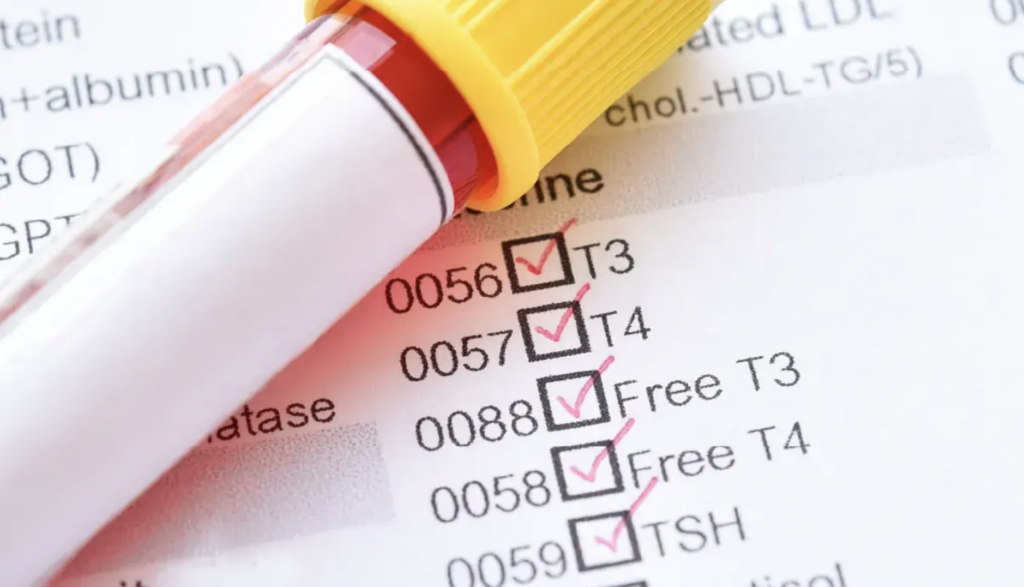The thyroid is a small, arch-shaped gland located in the front of the neck that plays a crucial role in regulating metabolism by producing and storing thyroid hormones, primarily:
- Thyroxine (T4)
- Triiodothyronine (T3)
Thyroid hormones contain iodine, an essential trace element that is absorbed from our food. The thyroid gland uses this iodine, attaching it to the molecule that will become T3 or T4. In fact, it is such an integral part of these hormones, that they were named based on how many iodine molecules they have: T3 has 3 iodine molecules, and T4 has 4 iodine molecules.
Functions of thyroid hormones
Thyroid hormones are involved in numerous body functions. Their main role is to stimulate protein production in various tissues and increase oxygen utilization by cells, resulting in an increase in the body’s metabolism.
T4 is the main hormone produced by the thyroid gland and has a slight impact on accelerating metabolism. However, T4 is converted to the more active form, T3, mainly in the liver and other tissues. The conversion of T4 to T3 is influenced by several factors, such as the body’s needs at a given time and the presence of diseases.
In addition to thyroid hormones, the thyroid gland also produces calcitonin, a hormone that can help strengthen bones by facilitating the incorporation of calcium into them.
Together, these hormones impact vital aspects such as heart rate, calorie burning, skin maintenance, growth, heat production, fertility, and digestion.
Thyroid hormone levels
Due to the importance of these hormones in a wide range of processes and their influence over most cells and tissues in the body, their production and secretion must be continuously controlled and regulated, which is no easy feat. However, the human body has developed a system that ensures these hormones are at the necessary level, in real-time.
How are thyroid hormones regulated?
Thyroid hormone regulation involves a finely tuned feedback process:
- It begins with the release of TRH by the hypothalamus in response to signals from the body and low levels of T4 and T3.
- TRH then stimulates the pituitary gland to produce TSH.
- TSH travels in the bloodstream and stimulates the thyroid gland to produce and release T3 and T4.
- As T4 and T3 levels increase, negative feedback is triggered that stops further TRH and TSH release, thus maintaining hormonal balance.
Metabolic needs, adaptation to stressful situations and iodine availability also influence the regulation of thyroid hormones. This regulation ensures an adaptive response of the body to changing conditions, maintaining an appropriate hormonal balance for optimal body function.

What are normal thyroid hormone levels and how are they measured?
When some hormones, such as T3 and T4, are released into the bloodstream, a proportion of the hormone molecules travel freely, while the rest of them travel attached to a protein. The part that travels attached to a protein does not affect tissues, while the “free” hormone does.
To assess thyroid hormone status, TSH, T4, and T3 levels are analyzed.
In this setting, free T4 is the amount of T4 that is not attached to a protein, and therefore has an effect on tissues and organs, while total T3 means the total amount of T3 in the blood, including both free and protein bound T3.
- TSH tests:
Normal TSH values are roughly between 0.37 and 4.7 mIU/L.
The best way to initially assess how the thyroid gland is working, is to measure the TSH level in a blood sample. A normal level in healthy individuals indicates proper thyroid function.
Because TSH levels increase in response to low levels of thyroid hormones, and deceases in response to high levels of thyroid hormones:
If someone’s TSH levels are high, it most likely means that the thyroid gland isn’t producing T3 and T4 properly. This is known as hypothyroidism.
On the other hand, if someone’s TSH levels are low, it probably means that the thyroid gland is producing too much T3 and T4. This is known as hypothyroidism
- T4 tests:
A normal adult total T4 level ranges from 60 to 150 nmol/L.
T4 circulates protein-bound and free. Free T4 is crucial in assessing thyroid function. Elevated levels indicate hyperthyroidism, while low levels indicate hypothyroidism.
The combination of TSH and free T4 provides a more accurate assessment of thyroid function.
- T3 tests:
A normal adult total T3 level ranges from 1.2 to 2.7 nmol/L.
T3 tests are useful in diagnosing and evaluating hyperthyroidism. High T3 levels indicate excessive thyroid activity.
The test is less useful in hypothyroidism as it is the last measurement to change in this case.
Diseases caused by thyroid hormone dysregulation
According to the American Thyroid Association (ATA), it is estimated that women are 5 to 8 times more likely to have thyroid problems than men. And that one in 8 women will develop a thyroid problem at some point during their lifetime.
Hyperthyroidism
In situations where there are elevated levels of thyroid hormone in the blood, we speak of hyperthyroidism. This can happen because the thyroid gland produces too much T3 and T4, or because of damage caused to the thyroid, causing the cells to break, and the hormone stored in them to leak into the blood. Elevated levels of thyroid hormone can cause an acceleration of metabolism in the body, thus causing different symptoms such as:
- Nervousness
- Anxiety
- Hyperactivity
- Weight loss
- Swelling of the thyroid gland, resulting in a lump in the throat called a goiter.
Women are 10 times more likely than men to have an overactive thyroid gland, and symptoms usually begin between the ages of 20 and 40.
Common causes of hyperthyroidism
- Graves’ disease: the most common cause of hyperthyroidism. It is an autoimmune disease where the immune system produces an antibody that stimulates the thyroid to produce and secrete T3 and T4 all the time.
- Thyroiditis or inflammatory thyroid disease: this is a group of diseases which result in the inflammation of the thyroid gland. In these cases, the hormones leak out of damaged thyroid cells, making T3 and T4 levels increase. After the cells run out of hormones, they’re not able to produce more because of the damage, which can lead to hypothyroidism.
- Plummer disease or Toxic solitary goiter: An abnormal non-cancerous growth in the thyroid gland that produces thyroid hormones independently, without responding to the body’s regulatory signals.
Possible treatments for hyperthyroidism
- Antithyroid medications, such as methimazole or propylthiouracil, to inhibit the production of thyroid hormones.
- Beta-blockers, such as propranolol, which block the effects of thyroid hormones thus relieving symptoms such as tachycardia and anxiety.
- Radioactive iodine treatment to destroy overactive thyroid cells.
- Surgery to remove some or all of the thyroid gland.

Hypothyroidism
In some cases, the thyroid is not able to produce enough thyroid hormones, this is known as hypothyroidism. Insufficient production of these hormones can lead to a variety of symptoms and health problems. Common symptoms:
- Include fatigue, weight gain
- Sensitivity to cold
- Dry skin
- Brittle hair
- Depression
- Constipation
- Other problems related to metabolism and energy.
Common causes of hypothyroidism
- Autoimmune disease: this is a common cause of hypothyroidism. In Hashimoto’s disease, the immune system attacks the thyroid gland, leading to inflammation and damage to the cells that produce thyroid hormones.
- Iodine deficiency: Iodine is a key component in the production of thyroid hormones. Lack of iodine in the diet can lead to decreased production of these hormones and, eventually, hypothyroidism.
- Congenital disorders: Some babies are born without a thyroid gland or with a gland that is only partially formed.
- Thyroiditis or inflammatory thyroid disease: Usually caused by an autoimmune attack or viral infection. This can cause a temporary release of large amounts of thyroid hormones followed by a decrease in production, leading to hypothyroidism.
- Radioactive iodine treatment or surgery: People who have received radioactive iodine treatment for thyroid conditions or have had surgery to remove part or all the thyroid glands may no longer be able to produce these hormones because of this.
- Medication side effects: Some medications can interfere with thyroid function and cause hypothyroidism as a side effect.
Treatment of hypothyroidism
Hypothyroidism cannot be cured, but it can be managed by administering synthetic thyroid hormones identical to the T4 produced by the body, thus compensating for the deficiency, and restoring normal levels in the body.
Research on thyroid diseases
Currently, there are several interesting clinical trials that seek to delve deeper into this type of disease to find new treatments that can facilitate the lives of people suffering from the disease.
An example could be the latest study of the University of Indiana (NCT05435547), which is now in the recruitment phase of patients. They are studying a potential way to make surgical treatment of autoimmune thyroid disease easier. They intend to determine whether a short course of corticosteroids (Dexamethasone) will reduce inflammation of the gland and if this effect will facilitates surgery.
In general, research on thyroid problems plays a key role in improving women’s health and well-being. It helps to understand and address the specific challenges women face and other impacts on quality of life. The aim is to search for treatments that offer more effective solutions tailored to individual needs, with the ultimate goal of giving women a fuller and healthier life.
